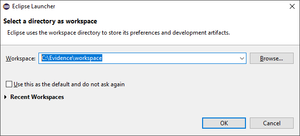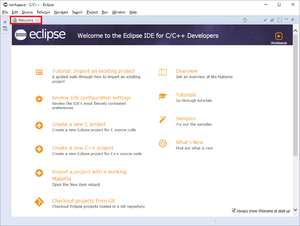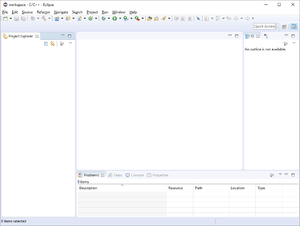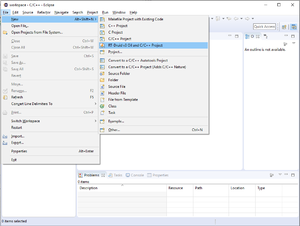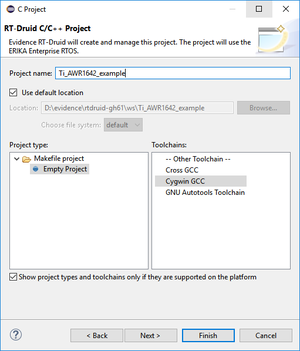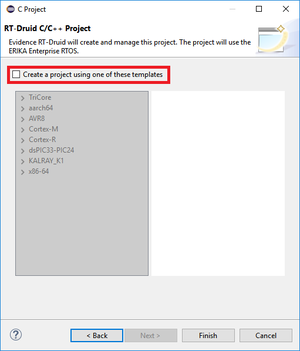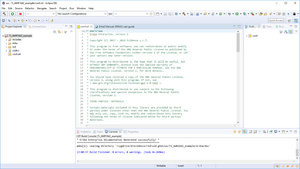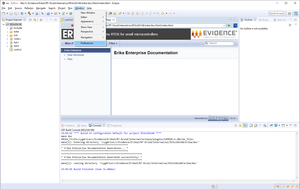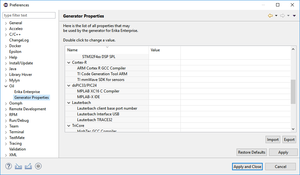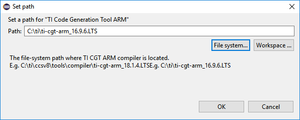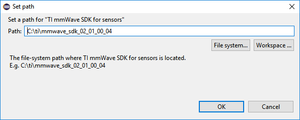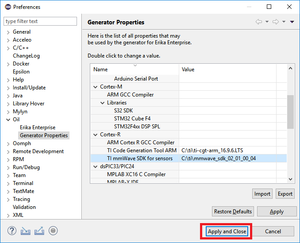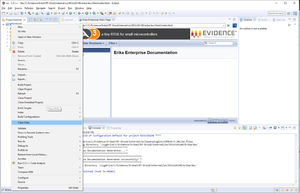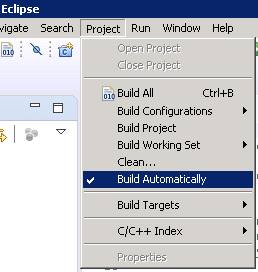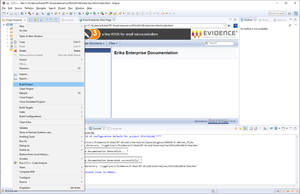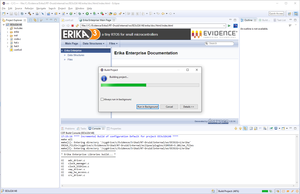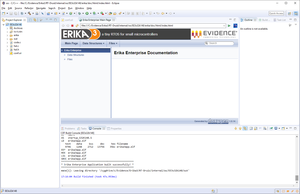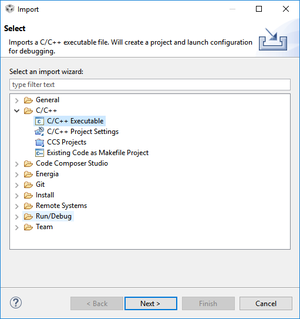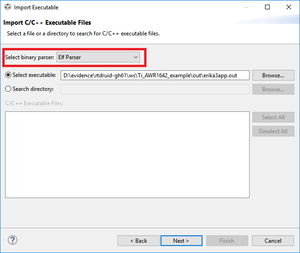Difference between revisions of "TI AWR1642 build with RT-Druid"
From ERIKA WIKI
E.Guidieri (talk | contribs) (→How to debug the project with CCS) |
E.Guidieri (talk | contribs) (→How to debug the project with CCS) |
||
| Line 119: | Line 119: | ||
* Open CCS v8 and right click on ''project explorer'' select Import->Import in Wizard Windows select C/C++->C/C++ Executable | * Open CCS v8 and right click on ''project explorer'' select Import->Import in Wizard Windows select C/C++->C/C++ Executable | ||
| − | [[File:TI AWR1642 tutorial | + | [[File:TI AWR1642 tutorial 16.png|thumb|center|Figure 22: Import RT-Druid Project as C/C+ executable in CCS v8.]] |
| + | |||
| + | * Change the binary parse frpom the default COFF to elf (the highlighted combo box in the following pictures) | ||
| + | |||
| + | * Search the erikaapp.out file inside the RT-Druid project/out folder | ||
| + | |||
| + | * Select ''Next'' | ||
| + | |||
| + | [[File:TI AWR1642 tutorial 22.png|thumb|center|Figure 22: Select RT-Druid Project out erika3app.out as executable.]] | ||
| + | |||
| + | * '''Important''' check the checkbox ''Create a Launch Configuration'' | ||
| + | * '''Important''' in the corresponding combo box select ''Code Compose Studio - Device Debugging'' | ||
| + | |||
| + | [[File:TI AWR1642 tutorial 23.png|thumb|center|Figure 22: Create the Code Compose Studio - Device Debugging confguration]] | ||
[[Category:Tutorial]] | [[Category:Tutorial]] | ||
Revision as of 16:04, 25 February 2019
Contents
Synopsys
This guide illustrates how to build and run a first ERIKA Enterprise v3 application for AWR1642BOOST
- Using the Eclipse environment (this wiki page)
- OIL File editing integrated in Eclipse
- No integrated debugger support (you will need CCS v8 or Lauterbach Trace32 (for lauterbach no specific instruction are provided))
Prerequisites
Please remember to install CCS v8 and MMWAVE-SDK 02_01_00_04 to obtain the full functionality described in this tutorial.
Additional information on prerequisites is available at the Quick Start Guide - Prerequisites.
RT-Druid Eclipse IDE
- Double-click the eclipse.exe application located in the eclipse folder extracted from the RT-Druid Package. Then, the workspace selection window will appear as shown in the following figure:
- Browse the file-system to select Workspace folder and then click on the OK button to let the RT-Druid Eclipse IDE start as shown in the following figure:
- Click on the Welcome tab-sheet close button to show the default RT-Druid Eclipse IDE C/C++ perspective as shown in the following figure:
RT-Druid Template Project
- Click on File->New->RT-Druid v3 Oil and C/C++ Project menu entry as shown in the following figure:
- The RT-Druid C/C++ Project Wizard will open as shown in the following figure:
- Type the name of the project in the Project name text-box (e.g., TI_AWR1642_example).
- Make sure the Cygwin GCC toolchain is selected and then click on the Next button.
- The wizard will show the window to select a project template as shown in the following figure:
- Click on Create a project using one of these templates check-box to let the Template Wizard to show the available templates as shown in the following figure:
- Expand the Cortex-R and TI AWR1642 entries and choose the desired template to instantiate: Full Demo.
- Finally, click on the Finish button to instantiate an RT-Druid Eclipse project from a chosen template as shown in the following figure:
RT-Druid Configuration
- Click on the Window->Preferences menu entry as shown in the following figure:
- The RT-Druid Eclipse Preferences window will open as shown in the following figure:
- Click the Generator Properties entry in the OIL section of the left panel to show the RT-Druid Generator Properties to configure.
- Double-click on the TI Code Generation Tool ARM property to configure the TI CGT ARM C Compiler installation path as shown in the following figure:
- Browse the file-system to select the ARM GCC Compiler path (E.g. C:\ti\ti-cgt-arm_16.9.6.LTS) and then click the OK button. N.B. This specific version of the compiler in this specific position in installed by mmWave SDK 02_01_00_04 installer
- Double-click on the TI mmWave SDK for sensors property to configure the S32 SDK installation path as shown in the following figure:
- Browse the file-system to select the TI mmWave SDK for sensors path (E.g. C:\ti\mmwave_sdk_02_01_00_04) and then click the OK button.
- Finally, click the Apply and Close button to confirm the configuration properties as shown in the following figure:
ERIKA distribution clean
- Right-Click on TI_AWR1642_example project into Eclipse Project Explorer panel and click on Clean Erika context-menu entry as shown in the following figure:
- The Clean up Erika Files dialog window will appear as shown in the following figure:
- Click on the Yes button to clean the whole ERIKA distribution.
NOTE: the distribution folder will be automatically regenerated if the flag Build Automatically is enabled.
NOTE: this operation may be necessary every time an ERIKA or RT-Druid configuration property is modified.
ERIKA project build
- Right-click on TI_AWR1642_example project into Eclipse Project Explorer panel and click on Build Project context-menu entry as shown in the following figure:
- The build process starts as shown in the following figure:
- The build process ends successfully as shown in the following figure:
How to debug the project with CCS
- Open CCS v8 and right click on project explorer select Import->Import in Wizard Windows select C/C++->C/C++ Executable
- Change the binary parse frpom the default COFF to elf (the highlighted combo box in the following pictures)
- Search the erikaapp.out file inside the RT-Druid project/out folder
- Select Next
File:TI AWR1642 tutorial 22.png
Figure 22: Select RT-Druid Project out erika3app.out as executable.
- Important check the checkbox Create a Launch Configuration
- Important in the corresponding combo box select Code Compose Studio - Device Debugging
